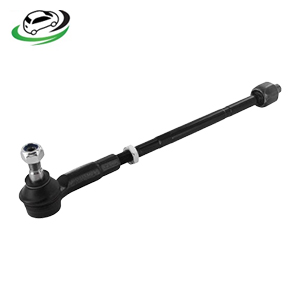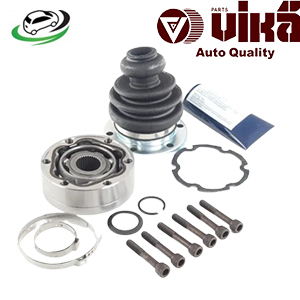-13%
Get Right Tie Rod Assembley VW Jetta MK4 GL/GLS/GLX/TDI/ Golf MK4 GL/GLS/GTI/TDI/ Golf IV GL/GLS/GLS/TDI/ Beetle Base 2.5/GLS/TDI/S/SE 1J0422804B
The steering tie rod is a critical component in a vehicle’s steering system, connecting the steering rack to the steering knuckle on each front wheel. This connection allows the driver’s input from the steering wheel to be translated into the movement of the wheels, enabling precise control of the vehicle’s direction. Understanding the function, types, benefits, common issues, and maintenance of steering tie rods is essential for appreciating their role in vehicle dynamics and safety.
Structure and Function of Steering Tie Rods
A steering tie rod is composed of several parts that work together to ensure smooth and accurate steering.
Components of a Steering Tie Rod
- Inner Tie Rod: Connected to the steering rack, the inner tie rod transfers movement from the steering mechanism to the outer tie rod.
- Outer Tie Rod: Connected to the steering knuckle, the outer tie rod is responsible for turning the wheel.
- Tie Rod End: The tie rod end features a ball-and-socket joint that allows for the necessary pivoting movement.
- Adjusting Sleeve: This component connects the inner and outer tie rods, allowing for adjustments in length to achieve proper wheel alignment.
Function in Steering System
The primary function of the steering tie rod is to transmit the motion from the steering rack to the wheels, allowing them to turn left or right. When the driver turns the steering wheel, the steering rack moves the inner tie rod, which then moves the outer tie rod and, consequently, the wheel. The ball-and-socket joint in the tie rod end allows for the necessary pivoting movement, accommodating the up-and-down motion of the suspension.
Types of Steering Tie Rods
There are two main types of steering tie rods, each suited to different steering system configurations.
Rack-and-Pinion Tie Rods
Rack-and-pinion systems are commonly found in modern vehicles due to their simplicity and precision. In these systems, the tie rods connect directly to the steering rack, which converts the rotational motion of the steering wheel into the linear motion needed to turn the wheels.
Recirculating Ball Tie Rods
Recirculating ball systems are typically found in larger vehicles such as trucks and SUVs. In these systems, the tie rods connect to a series of linkages and the recirculating ball gearbox, which uses ball bearings to reduce friction and wear while translating the steering wheel’s motion to the wheels.
Benefits of Steering Tie Rods
Steering tie rods offer several benefits that enhance vehicle performance, safety, and handling.
Precise Steering Control
Steering tie rods play a crucial role in providing precise control over the vehicle’s direction. By accurately transmitting the driver’s input from the steering wheel to the wheels, tie rods ensure responsive and predictable steering.
Enhanced Handling
Properly functioning tie rods contribute to improved handling by maintaining accurate wheel alignment. This alignment ensures that the vehicle responds correctly to steering inputs, providing better control and stability, especially during cornering and maneuvering.
Increased Safety
Steering tie rods are vital for vehicle safety, as they ensure that the wheels respond correctly to steering commands. Worn or damaged tie rods can lead to steering issues, such as looseness or imprecision, which can compromise the driver’s ability to control the vehicle, especially in emergency situations.
Longevity and Durability
Modern tie rods are designed for durability, often featuring high-quality materials and advanced engineering to withstand the stresses of driving. This durability reduces the need for frequent replacements and maintenance, contributing to overall vehicle reliability.
Common Issues and Maintenance of Steering Tie Rods
Like all mechanical components, steering tie rods are subject to wear and tear over time. Regular inspection and maintenance are crucial for ensuring their proper function and extending their lifespan.
Signs of Worn Steering Tie Rods
- Steering Play: Excessive play or looseness in the steering wheel can indicate worn tie rods.
- Uneven Tire Wear: Misalignment caused by worn tie rods can lead to uneven tire wear.
- Vibration: Vibration or shaking in the steering wheel, especially at higher speeds, can be a sign of tie rod issues.
- Clunking Noise: A clunking or knocking sound when turning the steering wheel or driving over bumps can indicate worn or damaged tie rods.
Maintenance Tips
- Regular Inspection: Periodically inspect tie rods for signs of wear, damage, or contamination.
- Alignment Checks: Regularly check and adjust wheel alignment to ensure even tire wear and optimal handling.
- Timely Replacement: Replace worn or damaged tie rods promptly to avoid further steering and suspension issues.
Advances in Steering Tie Rod Technology
Modern advancements in steering tie rod technology have led to improved performance, durability, and ease of maintenance.
High-Quality Materials
The use of advanced materials, such as high-strength steel and durable composites, enhances the strength and longevity of tie rods. These materials are designed to withstand the stresses of driving while providing consistent performance.
Improved Engineering
Modern tie rods feature enhanced engineering, including better ball-and-socket joint designs and improved seals that protect against contamination and wear. These advancements contribute to smoother steering and longer component life.
Advanced Manufacturing Techniques
Precision manufacturing techniques ensure that modern tie rods meet high standards of quality and consistency. These techniques result in components that provide reliable performance and require less frequent maintenance.
Follow us on Facebook for more parts.


